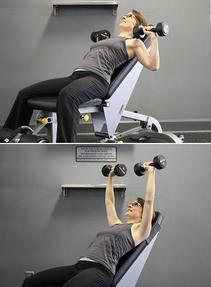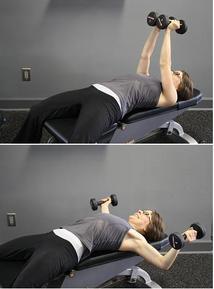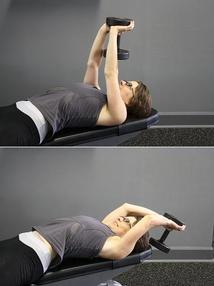Flat bench press

1. Lie on the bench with your back pressed firmly against the bench.
2. With a tight grip on the barbell, make sure that it is balanced between both sides of your body.
3. Take the barbell off the rack. Slowly lower it to the chest, keeping your elbows away and outward from your body.
4. As you lower the weight, be sure not to bounce it. Lightly touch the chest and push the weight back up in a controlled way without locking your elbows.
Muscles Targeted: The barbell bench press is a compound exercise that primarily hits the chest, but also involves the triceps and the front deltoids, as well as the upper and lower back muscles, and traps. The bench press is to the upper body what the squat is for the legs.
Incline dumbbells press

1. Pick up two dumbbells and sit down on an incline bench.
2. With the dumbbells in your hands, lie on the incline bench, pressing your back against it.
3. Bring the dumbbells to the sides of your torso at chest level and press the weight up. The dumbbells should be held directly over your chest area, slightly touching each other with palms facing forward.
4. By bending your arms, slowly lower both dumbbells to a position where you feel the stretch of your chest. The dumbbells should now be at the sides of your chest.
5. Slowly press the weight back up to the starting position. Do not bounce the weight from the chest. Keep your elbows out and away from your body.
Muscles Targeted: The incline bench press focuses on similar muscle groups as the flat bench, but puts more stress on the shoulders and includes the trapezius muscles. Your upper chest or pectoralis minor is recruited more heavily than in the flat bench. This extra recruitment can help build the chest muscles near the collarbone and give a more rounded look to your chest. Your anterior deltoids and triceps still play a major part in raising the bar.
2. With the dumbbells in your hands, lie on the incline bench, pressing your back against it.
3. Bring the dumbbells to the sides of your torso at chest level and press the weight up. The dumbbells should be held directly over your chest area, slightly touching each other with palms facing forward.
4. By bending your arms, slowly lower both dumbbells to a position where you feel the stretch of your chest. The dumbbells should now be at the sides of your chest.
5. Slowly press the weight back up to the starting position. Do not bounce the weight from the chest. Keep your elbows out and away from your body.
Muscles Targeted: The incline bench press focuses on similar muscle groups as the flat bench, but puts more stress on the shoulders and includes the trapezius muscles. Your upper chest or pectoralis minor is recruited more heavily than in the flat bench. This extra recruitment can help build the chest muscles near the collarbone and give a more rounded look to your chest. Your anterior deltoids and triceps still play a major part in raising the bar.
Lying dumbbell flyes

1. Grasp two dumbbells and carefully lie down on a flat bench.
2. Press your back firmly against the padding and the weight up, so that the dumbbells are directly over your chest, with your palms facing inward.
3. In an arc like motion, carefully lower your arms out to the side of your body toward the floor until you can feel the stretch in your chest.
4. Bring the weight back up. The elbows remain slightly bent throughout the whole movement.
Keep in mind that throughout the movement, the arms should remain stationary; the movement should only occur at the shoulder joint.
Muscles Targeted: This exercise works the pectorals. Other muscles worked include deltoids, triceps, and forearms. Like the dumbell pullover the dumbell flyes will stretch the pectoralis quite a lot. Therefore, it is a good way to end a chest work out with this exercise.
Pullovers

1. Grasp a heavy dumbbell and lie down on a bench with your head at the end of the bench.
2. Holding the dumbbell in a vertical position, slowly lower it behind your head until you feel the stretch of your chest. While performing this exercise, your arms should have a slight bend to them at all times.
3. Raise the dumbbell back to its starting position. Concentrate on using your chest muscles (rather than your back!) to do so.
Note on the position of the feet for all exercises described above: When you are a beginner, it´s a good idea to put your feet up like demonstrated in some of the pictures. This way it´s a lot easier to keep your back “glued” to the bench. In addition, you´ll learn to balance the weight properly. Once you have built a strong core and you start using heavier weight, you probably will want to put your feet on the ground for stability reasons. But you do have to remember to keep your back pressed to the bench while performing these exercises!
Muscles Targeted: The dumbbell pullover can be considered a back exercise or a chest exercise, since the major muscle groups exercised are the back and chest. In order to primarily target the chest, you need to concentrate on squeezing your pecs, actually moving the weight with the chest, rather than the back. It takes some practise.
2. Holding the dumbbell in a vertical position, slowly lower it behind your head until you feel the stretch of your chest. While performing this exercise, your arms should have a slight bend to them at all times.
3. Raise the dumbbell back to its starting position. Concentrate on using your chest muscles (rather than your back!) to do so.
Note on the position of the feet for all exercises described above: When you are a beginner, it´s a good idea to put your feet up like demonstrated in some of the pictures. This way it´s a lot easier to keep your back “glued” to the bench. In addition, you´ll learn to balance the weight properly. Once you have built a strong core and you start using heavier weight, you probably will want to put your feet on the ground for stability reasons. But you do have to remember to keep your back pressed to the bench while performing these exercises!
Muscles Targeted: The dumbbell pullover can be considered a back exercise or a chest exercise, since the major muscle groups exercised are the back and chest. In order to primarily target the chest, you need to concentrate on squeezing your pecs, actually moving the weight with the chest, rather than the back. It takes some practise.
